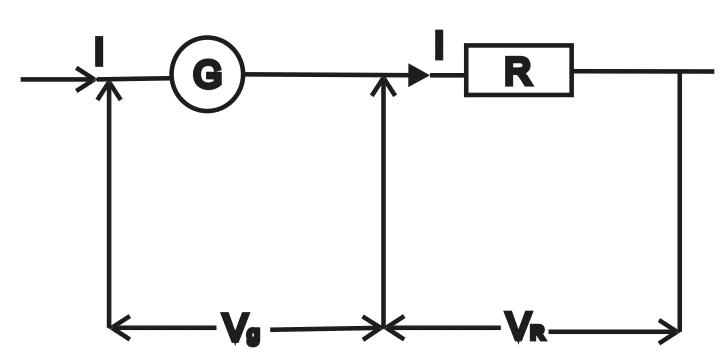Multiplier
A small galvanometer which is used for measuring small current can be converted to a multiplier. This is achieved by connecting a high resistance (resistor) in series with the galvanometer in order to convert it to voltmeter

V = Vg+ VR
V = Voltage across the whole circuit
Vg = voltage along the galvanometer
Vm = voltage across the multiplier
Rg = resistance across the galvanometer
Rm = resistance across the multiplier
Since galvanometer and multiplier are in the same series, the same amount of current flows through them
I = \( \frac {V_g}{R_g} = \frac {V_m}{R_m} = \frac {V_r}{R_m} \)
Example
A galvanometer of resistance 6Ω and full scale deflection (f.s.d) of 50MA is used to measure a P.d of 60V. Calculate the resistance of the multiplier.
Solution
Galvanometer current = 50MA = 0.05A
Voltage across galvanometer Vg = IRg = 0.05 × 6 = 0.30V
Voltage across multipliers, V = Vg + Rm
60 = 0.30 + Vm
Vm = 60 – 0.30 = 59.7V
The galvanometer and multiplier are in series, the same current passes through them;
\( \frac {V_g}{R_g} = \frac {V_m}{R_m}\) \( \frac {0.3}{6} = \frac {59.7}{R_m}\)Rm =\( \frac {59.7 \times 6}{0.30}\)
Rm = \( \frac {35.82}{0.30}\)
Rm = 1191Ω
Shunt
A low resistance (resistor) connected in parallel across a galvanometer to convert it to ammeter is called shunt.

Rg = resistance of the galvanometer
Ig = current in the galvanometer
Rs = resistance of the shunt
Is = current in the shunt
From the diagram
I = Ig + Is
Since the same P.d passes through them, being parallel,
Vg = Vs
IgRg = IsRs
Example:
A galvanometer of resistance 3Ω has an f.s.d for a current of 100MA. Calculate the resistance of the shunt required to convert it to a 5A ammeter
Solution
Ig = 100MA, Rg =3Ω
I = Ig + Is
5 = 0.1 + Is
5 – 0.1 = Is
Is = 4.9A
Vg = Vs
Ig x Rg = Is x Rs
Rs = \( \frac{0.1 \times 3 }{49} \)
=0.06Ω



Responses